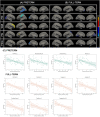Association between cortical thickness and cognitive ability in very preterm school-age children
- PMID: 38287104
- PMCID: PMC10825161
- DOI: 10.1038/s41598-024-52576-5
Association between cortical thickness and cognitive ability in very preterm school-age children
Abstract
Very preterm children, born before 32 weeks of gestation, are at risk for impaired cognitive function, mediated by several risk factors. Cognitive impairment can be measured by various neurodevelopmental assessments and is closely associated with structural alterations of brain morphometry, such as cortical thickness. However, the association between structural alterations and high-order cognitive function remains unclear. This study aimed to investigate the neurodevelopmental associations between brain structural changes and cognitive abilities in very preterm and full-term children. Cortical thickness was assessed in 37 very preterm and 24 full-term children aged 6 years. Cortical thickness analysis of structural T1-weighted images was performed using Advanced Normalization Tools. Associations between cortical thickness and the Wechsler Intelligence Scale for Children were evaluated by regression analysis based on ordinary least square estimation. Compared with full-term children, very preterm children showed significant differences in cortical thickness, variously associated with cognitive abilities in several brain regions. Perceptual reasoning indices were broadly correlated with cortical thickness in very preterm and full-term children. These findings provide important insights into neurodevelopment and its association with cortical thickness, which may serve as a biomarker in predictive models for neurodevelopmental diagnosis of high-order cognitive function.
© 2024. The Author(s).
Conflict of interest statement
The authors declare no competing interests.
Figures


Similar articles
-
Cortical morphometry and cognition in very preterm and term-born children at early school age.Early Hum Dev. 2018 Jan;116:53-63. doi: 10.1016/j.earlhumdev.2017.11.003. Epub 2017 Nov 24. Early Hum Dev. 2018. PMID: 29179056
-
Brain volumes and cortical thickness and associations with cognition in children born extremely preterm.Pediatr Res. 2025 Feb;97(2):655-663. doi: 10.1038/s41390-024-03480-1. Epub 2024 Aug 21. Pediatr Res. 2025. PMID: 39169225 Free PMC article.
-
Language performance and brain volumes, asymmetry, and cortical thickness in children born extremely preterm.Pediatr Res. 2024 Mar;95(4):1070-1079. doi: 10.1038/s41390-023-02871-0. Epub 2023 Nov 3. Pediatr Res. 2024. PMID: 37923870 Free PMC article.
-
Atypical neuromagnetic resting activity associated with thalamic volume and cognitive outcome in very preterm children.Neuroimage Clin. 2020;27:102275. doi: 10.1016/j.nicl.2020.102275. Epub 2020 May 19. Neuroimage Clin. 2020. PMID: 32480286 Free PMC article. Review.
-
The neurobiological correlates of cognitive outcomes in adolescence and adulthood following very preterm birth.Semin Fetal Neonatal Med. 2020 Jun;25(3):101117. doi: 10.1016/j.siny.2020.101117. Epub 2020 May 15. Semin Fetal Neonatal Med. 2020. PMID: 32451305 Review.
Cited by
-
Heterogeneous, temporally consistent, and plastic brain development after preterm birth.Nat Commun. 2025 Sep 12;16(1):8269. doi: 10.1038/s41467-025-63967-1. Nat Commun. 2025. PMID: 40940320 Free PMC article.
-
Neurocognitive difficulties in trauma-exposed adults with metabolic syndrome: no influence of PTSD status or PTSD and metabolic syndrome comorbidity.Discov Ment Health. 2025 Feb 20;5(1):16. doi: 10.1007/s44192-025-00141-5. Discov Ment Health. 2025. PMID: 39976743 Free PMC article.
-
Morphometric Measurement of Mean Cortical Curvature: Analysis of Alterations in Cognitive Impairment.Medicina (Kaunas). 2025 Mar 18;61(3):531. doi: 10.3390/medicina61030531. Medicina (Kaunas). 2025. PMID: 40142342 Free PMC article.
-
Prenatal inflammation exacerbates hyperoxia-induced neonatal brain injury.J Neuroinflammation. 2025 Feb 28;22(1):57. doi: 10.1186/s12974-025-03389-4. J Neuroinflammation. 2025. PMID: 40022130 Free PMC article.
-
Advances in magnetic resonance imaging of the developing brain and its applications in pediatrics.World J Pediatr. 2025 Jul;21(7):652-707. doi: 10.1007/s12519-025-00905-7. Epub 2025 May 30. World J Pediatr. 2025. PMID: 40442377 Review.
References
MeSH terms
LinkOut - more resources
Full Text Sources
Medical

